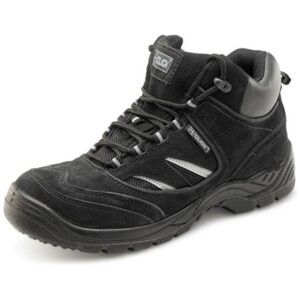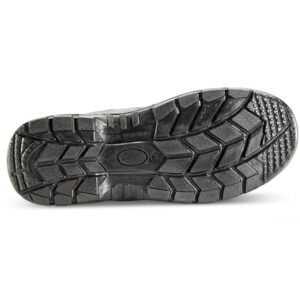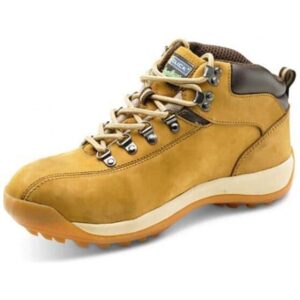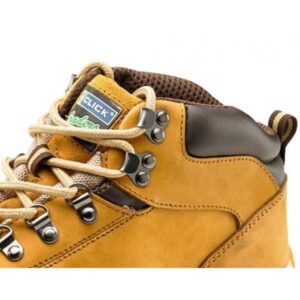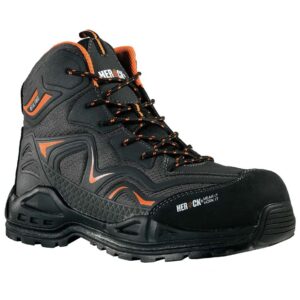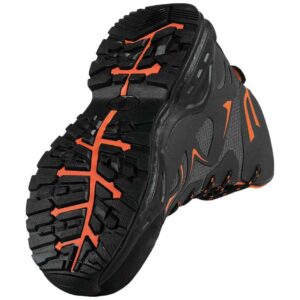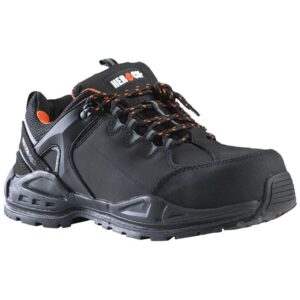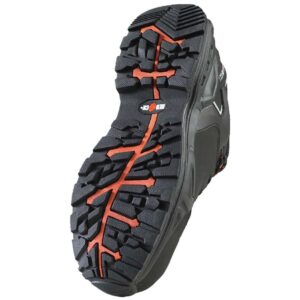When it comes to purchasing safety footwear, whether you’re buying your first pair of work boots or you’re looking to upgrade to something new, you might feel a bit overwhelmed at the selection available. Should you opt for high safety boots, or lower safety shoes, or what about safety trainers? Do you need waterproof safety boots, or will plain leather boots do the job?
Understanding exactly where you’ll be wearing your boots, and what work you’ll be doing in them is the first step to whittling down your options. Read our helpful guide to safety footwear, as well as some of the most commonly asked FAQs, below to help you decide.
What safety footwear should I choose?
Are you torn between safety shoes – should you choose high or low? – and safety boots? If you’re new to safety footwear it can be difficult to decide which will be the best option. To help you out we’ve created a handy visual guide to make your decision easier by examining the crucial differences.
The three main things to consider when making your safety footwear decision are:
- Do you require flexibility and movement for your foot inside your shoe?
This can be particularly important if your role requires you to crouch and kneel a lot. Safety footwear which doesn’t allow for any movement inside can feel quite restrictive and uncomfortable when you’re trying to kneel and flex your feet. - Will you be lifting heavy objects or carrying out heavy duty work?
You might not have previously considered it, but when you’re carrying out heavy duty work you can put the various tendons in your foot and ankle at risk – most crucially, your achilles tendon. Therefore, it’s important to think about footwear which provides support and protection for your feet and ankles. You’ll also want to ensure your safety boots or shoes have a midsole – which is key to protecting your feet if you stand on any sharps. - Will you be working in damp or wet environments?
If you’re working in wet conditions then you’ll want to keep your feet as dry and warm as possible.
TOP TIP – Finding the perfect fit
When it comes to trying on your new safety footwear, remember that your feet need to feel comfortable and able to move freely within your shoes or boots. You should be able to comfortably place a finger down the back of your heel when you slide your toes to the front of your shoes. We also advise trying your new workwear shoes on in the morning as well as in the evening. Your feet tend to swell up throughout the day due to heat and exertion, so you’ll want to ensure they’re comfortable all day long.
What do the different safety classes mean?
If you’ve been browsing through different safety shoes and boots, you’ll have noticed by now the various safety codes that are used to describe the features the boots have and the regulations they meet. All safety footwear must comply with the European Safety Standards ISO 20345. All footwear which meets these standards will then be broken down into one of the main S (Safety) classes.
Let us break down exactly what the four most popular safety footwear classes actually mean.
When shopping for your safety footwear, decide which of these features is essential to you and then make sure you look for that all important safety code in the product description. We would strongly recommend avoiding any products deemed as ‘safety footwear’ which do not include a reference to the European Safety Standards. When it comes to your own workplace safety, you don’t want to be taking any risks.
Frequently Asked Questions about Safety Footwear
We hope you now have a better understanding about the main differences between safety boots vs safety shoes, and which safety codes you want to look out for when shopping. But we know there’s often more to that when it comes to deciding on the perfect pair of work boots.
So to make sure we’ve answered all of your concerns, we wanted to address some of the most commonly asked questions when it comes to safety footwear.
Why wear safety boots?
Safety boots, or any form of safety footwear, are a workplace essential. Not only can they protect you from a multitude of injuries including broken bones, chemical burns, cuts and bruises, but they also protect your feet from any long term damage by providing adequate comfort and support. Buy good quality safety footwear now, and your feet will reap the benefits later in life.
Are safety boots classed as PPE?
Safety boots are subject to the same strict regulations as any other workplace protective clothing, such as hard hats and safety goggles, and are therefore classed as PPE. Find out more about the HSE’s regulations on footwear here.
What are S3 Safety boots?
We hope after reading our guide to the most popular Safety Footwear Standards that you’ll now have a better understanding. But to recap, S3 Safety Boots are boots designed with a protective toe cap, fully enclosed heel, a water resistant upper and an anti perforation sole.
Are safety boots waterproof?
Not all safety boots are actually water resistant, so if you’re looking for waterproof safety boots look out for any boots which are S2 class and above (up to S5). These will be made from a water resistant upper.
Are safety boots a legal requirement?
They are! Construction workers are legally obliged to wear substantial safety footwear whilst on site and carrying our heavy duty work. Find out more about this here.
Are safety boots VAT free?
When safety boots are purchased by an individual for industrial use, they are subject to 0% VAT. However, if safety boots are purchased by an employer for use by their employees then VAT does apply. This ruling is specific to safety boots and does not include shoes. Full details of the VAT exemption and which footwear is included, can be found here.
Can safety boots be used for hiking?
You can – but bear in mind that safety boots, especially if they’re steel toed, will be a lot heavier than a typical pair of hiking boots. So we’d advise only wearing them on shorter hikes. The high level of ankle and foot-arch support actually makes them a great option for hiking. However, safety boots don’t tend to be made from particularly breathable fabrics – something to consider if you’ll be hiking in hot weather.
How much weight can safety boots take?
It’s important to remember that this will vary from boot to boot, dependent on various factors. But generally speaking a steel toe safety boot can withstand a weight of 6000 pounds. A composite toe can withstand up to a similar amount.
How to make safety boots more comfortable?
First of all, it’s important to make sure your safety footwear is as comfortable as possible from the off. That’s why we recommend following our top tips for finding the perfect fit above. If your safety shoes or boots are still causing you some discomfort, we’d advise you to try and wear them in as much as possible. Wear them round the house and for short stints to begin with, always ensuring you wear appropriate thick workwear socks. However, we believe that safety footwear shouldn’t really be uncomfortable at all. If it is, then maybe it’s time to find a new brand which better suits your needs.
We hope our ultimate guide to safety footwear will help get you off on the right foot when it comes to buying your next pair of safety boots of shoes. If you need any further advice, our team of experts are more than happy to help guide you in the right direction. Contact our team on [email protected].
-
£27.52 0% VAT
-
£46.60 0% VAT
-
£80.49 0% VAT
-
£79.99 inc VAT

